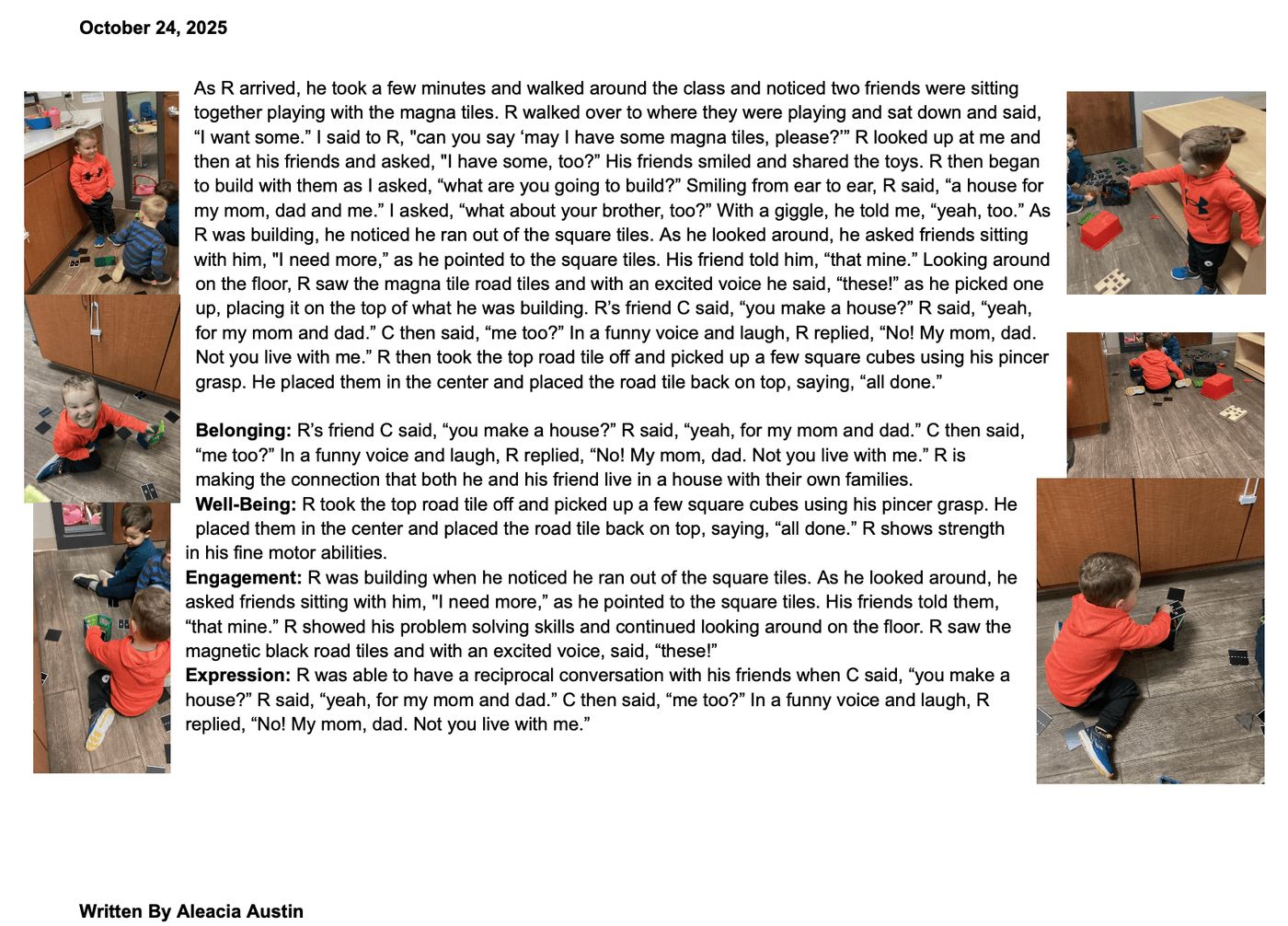
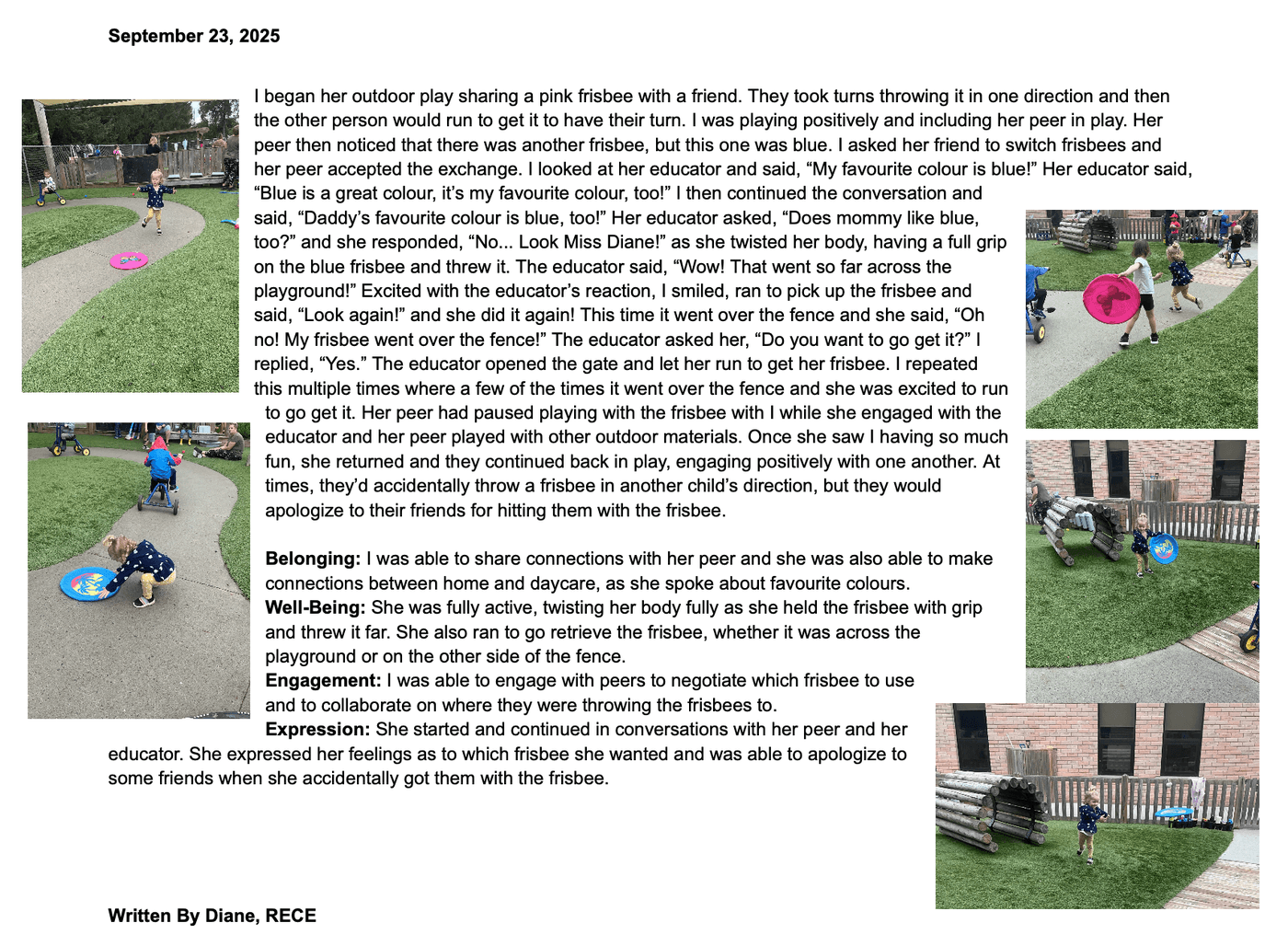
June 4, 2025
Ms Chelsea had drawn out a tree on some brown paper and taped it to the back of the door as Ms Aleacia set out a tray with green paint and some branches from the trees alongside our playground. As the children noticed it sitting there, L, E and C had come over and asked, “can we paint?” I replied, “of course you can! Let’s see what you guys can do!”
L walked up and picked up the branch with his left hand and dipped it into the green paint, walked over to the paper and with a quick swing, smacked the branch against the paper leaving an impression of the branch. He said to his friends, “wow, did you see that?” L laughed and then continued making prints on the door as E and C began slapping their branches against the paper, making the green paint splatter all over the paper. C and E turned and looked at one another as they both began to giggle. E said to C, "you have paint on your face,” with a big smile and wide eyes. C told E, “you do, too!” C and E both looked down and noticed green paint all over the floor. They both said at the same time, “Ms Aleacia, there is paint all over the floor. It needs to be cleaned up.”
”
As L, C and E were still painting, they got the attention of M, S and C as they walked over and all said, “we want a turn.” L turned and told them, “there are three branches so you guys have to wait until we are all finished our turn.” L, C and E each took a few more turns and then placed the branches down as L said, “I’m all done. I got paint all over me.” The girls included, “us too!” M, C and S all picked up a branch and began slapping the paper with the branches. As C went to swing his branch onto the paper, his friend S’s branch had bounced off the door, hitting C in the left ear. Right away, S said to C, “oops, sorry. This is pretty tricky.” C agreed and grabbed his shirt, wiping his ear clean as the two friends laughed. As M was dipping his branch, R came over and asked the group, “can I have a turn?” M then replied, "there are only three branches, but this one is big. I can make you one.” Using both hands, M broke a piece of the branch off and handed it to R, giving her the chance to have a turn. R said, “thank you M for helping me.” R then used her right hand to hold her branch and slid it back and forth on the paper. R then said to the group, “I can’t reach. Too high! I'm just painting down here.” As R was painting she said to her friends, "look at these marks, they are different than yours.” As I was taking pictures of the children, P came over and stood by watching. I then asked P, “would you like a turn to come and paint?” P stood quietly for a few moments and then, after thinking about it for a few seconds, replied, “after they are all done.” I told her that’s fine and then asked her, “are there are too many friends?” P nodded and waited patiently for a few friends to finish their turn. After some friends had finished, P walked over, picking up a branch using both hands, and walked over to the paper, smacking it against the paper twice with her right hand and then quickly turned around and placed the branch back down and told the educator, “I don’t like that. It’s too picky! The green things hurt my hand. I’m all done."
Belonging: The children socially interacted with one another when noticing paint on one another’s faces and well as the floor. Each child was participating in ways that they felt most comfortable, some waiting for when there were less friends at the activity.
Well-being: The children showed a sense of agency, recognizing that they have the right to make their own choices and decisions. Some chose a messier experience, getting paint on their bodies or experiencing the feel of the branches. They knew they had the choice to paint or not.
Engagement: The children focus their attention as to where they would like their branch to go on the paper and were able to communicate their feelings and ideas to one another. The children also collaborated with one another as to where they were going to be placing their branches and limited the experience to three friends at a time.
Expression: The children participated in meaningful interactions with peers by helping one another to ensure there were enough materials for each friend to experience making the tree and communicating their feelings to one another by asking and answering questions.
By Aleacia Austin
May 28, 2025
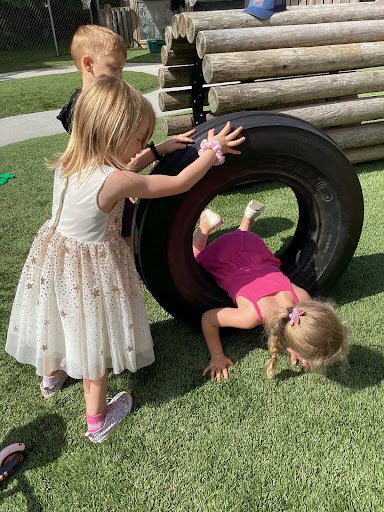
A was enjoying a beautiful day outside with her classmates. She was exploring the playground when she heard her friend yell out, “help!” A ran over quickly to find out what her friend needed. She found her friend struggling to hold up a big tire. “Help me hold up the tire,” her friend said. “Okay,” answered A. Once A began to help her, they were able to easily roll the tire around the playground. One of A’s classmates decided to try laying in the middle of the tire as she pushed it with the other friend. This idea didn’t work that well but it made everyone laugh hysterically. A then tried going in the middle as well, but that didn’t work out either and just added to the laughter. Then A and her classmates extended the play again by rolling the tire back and forth to one another. They had to concentrate and communicate to get the timing right but they were successful and had a lot of fun playing until it was time to head inside for lunch.
Belonging: When A’s friend called for help it was clear that she felt confident that she could help her. It was clear that A’s friend knew that she could trust her to help.
Well-Being: Playing with the heavy tire required plenty of physical activity by A and her friends. They had to use a broad stance and engage muscles in their arms, legs and core while they supported the tire on both sides.
Engagement: A and her friends expressed so much joy as they played with the tire. A was happy to collaborate so that they could play with the heavy tire.
Expression: The communication A had with her friends was incredibly meaningful. It was clear A is trusted by her friends to come when they need her help.
By Brianna Wall
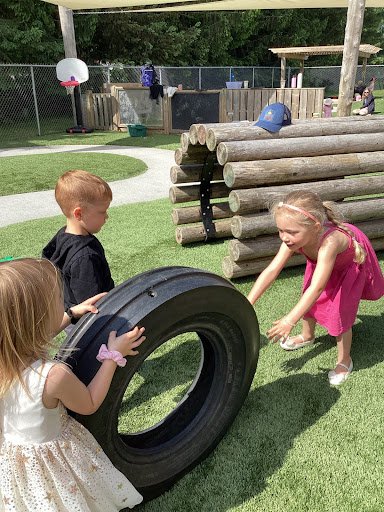
April 9, 2025
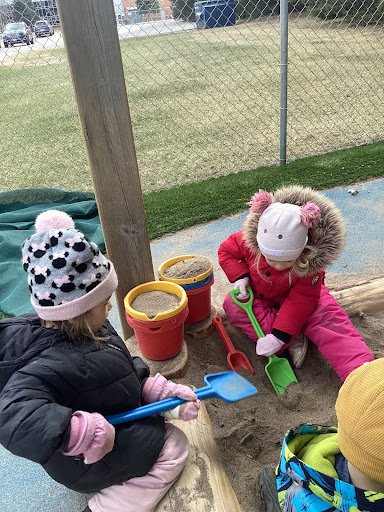
As I walked over to the sandbox, C and a peer were filling two buckets up with sand. I asked, “What are you two making?” C answered, “A cake and a pie!” pointing to the buckets. I said, “Oh yum, what kind?” C replied, “A chocolate cake and a chocolate pie.” I said, “Those sound really yummy, what are they for?” C cheered, “We’re throwing a party for our friends!” C and her peer continued scooping sand and filling up their buckets. Once the buckets were full they used the flat bottom side of their shovels to smooth and level the tops of their cake and pie. Another peer ran into the sandbox, asking, “Are you ready to play yet?” C replied, “Not yet, we still have to decorate them!” The peer jumped out of the sandbox, while C and her peer continued decorating. C gathered small wood chips and bark from in the sand box and stuck them in her cake. She said, “The candles are all done!” As her peer gently sprinkled sand off her shovel on top of her pie she added, “I’m just adding sprinkles.” C and her peer yelled for their peer, “We’re ready!” The peer returned to the sandbox and joined the girls while they “ate” their chocolate cake and chocolate pie.
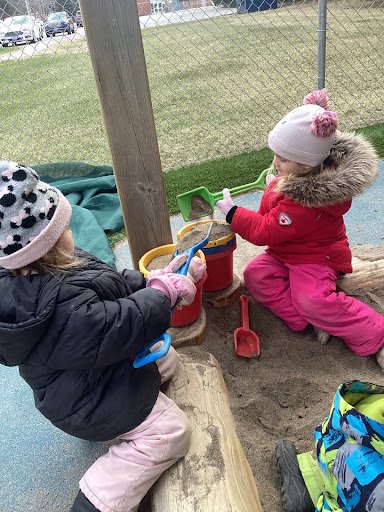
Belonging: C engaged in conversation with her educator, explaining what she and her peer were making in the sandbox. She worked collaboratively with her peer, exchanging ideas and how they were decorating their baked goods.
Well-being: C approached the sandbox with her peer and began filling up their buckets with sand. C explained to her educator that she was making a chocolate cake and a chocolate pie, initiating her own learning experience by engaging in dramatic play.
Engagement: C used the buckets as cake/pie pans, the sand as her ingredients and other loose natural materials she found in the sandbox to represent her ideas of the world around her and make baked goods for her and her peers to share.
Expression: C engaged in dramatic play with a peer in the sandbox to bake treats using natural materials she found outside, using creative expression.
By Chelsea Kelly, RECE
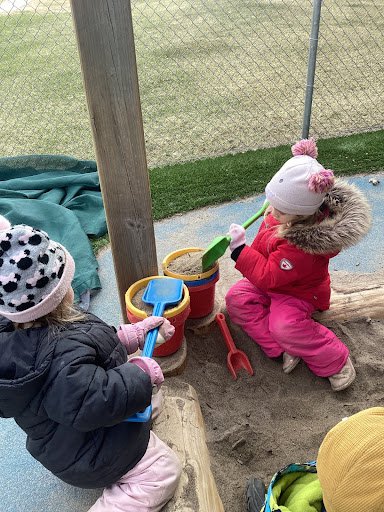
March 25, 2025
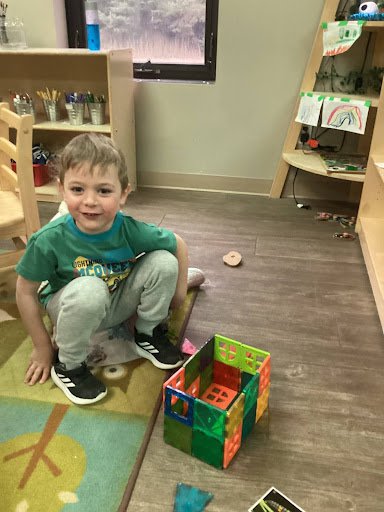
C gathered a stack of magnatiles from the shelf and carried them to a quiet area where he and a peer could begin building together. They started by laying pieces on the floor then building upwards, creating walls. C and his peer communicated with one another, deciding where each piece would be placed, including windows and doors. C said, “This is a castle for our babies, right?!” The peer giggled as she agreed, saying, “Yeah! This is for our babies!” I asked, “Are your sisters princesses?” C and his peer both cheered, “Yeah!” The peer added, “My baby sister's Bell and C’s baby sister is Sleeping Beauty!” I asked, “And who are you two?” The peer added, “I’m Cinderella and C is the King of the castle!” C laughed as he wrapped his arms around himself and said, “Yup! I’m the king!” C then explained the layout of their castle, pointing to each area where everyone had their own rooms, the door to get in and the stairs in their castle. When the castle was finished, C and his peer went to the art centre to draw pictures for their baby sisters. As they completed their pieces of art, they excitedly showed me what they had made. C asked, “Now we can go to their room and give it to them?” I said, “I think your sisters would love that.” I walked C and his peer down the hall to our infant room. Their sisters' faces lit up with big smiles as C and his peer entered the room. C was very excited to show his sister the picture he drew, handing it to her teacher to hang on their wall. We said goodbye then headed back to our classroom.
Belonging: C collaborated with his peer to build creatively using the magnatiles to design a castle for themselves and their sisters. C moved on to the art centre, drawing a picture for R that he wanted to deliver and hang in her classroom. His desire to bring his art piece to his sister was honoured by the educators.
Well-Being: C used his fine motor skills to create a picture for his sister and showed pride in his finished artwork. He was eager to deliver it to his sister with a big hug and lots of excitement as he ran in to surprise her.
Expression: C communicated back and forth with his peer to build together and share their ideas, and with his educator by explaining the design of their castle using reciprocal language. As C made his way to the art centre, he expressed himself creatively through his drawing using a variety of bright coloured markers.
Engagement: C maintained focus as he built cooperatively with his peer to construct a castle for everyone to live in, explaining the layout to his educator and where everyone had their own rooms. C used the magnatiles to represent his ideas and engage in communication with his educator about his creations.
By Chelsea Kelly, RECE
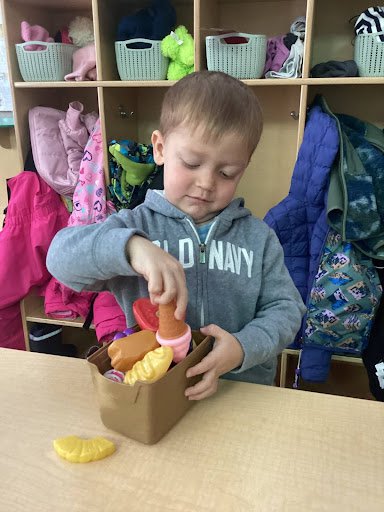
February 19, 2025
L and a peer were playing together in the kitchen. They took turns putting their cup in the microwave then ran over to another peer who was colouring at the table. They delivered her the drink and the peer shouted, “Here’s your hot chocolate!” Their peer pretended to drink the hot chocolate and they all giggled together. L ran back to the kitchen and grabbed a basket. He began filling it with food then brought it back to his peer at the table. I sat down at the table with Levi and his peer and asked, “What are you guys eating?” L said, “I made C lots of food and she ate all of it!” I said, “She must’ve been hungry!” L added, “She was, she ate it all!” L started gathering the food back up and carried his basket of food to the other end of the table and said, “This is for me now.” The peer laughed and said, “No, I’m still hungry.” L let out a sigh as he handed her an ice-cream cone, then they laughed together as they pretended to eat the food.
Belonging: L was playing with a peer in the kitchen area. He then approached another peer colouring at the table and brought her hot chocolate and lots of food, bringing her into his play scenario.
Well-Being: L gathered lots of food from the kitchen to bring his peer, then explained to his educator, “I made C lots of food and she ate all of it!” and agreed that she was very hungry. When L collected the food for himself and his peer said she was still hungry he shared more of his food with her and handed her an ice-cream cone.
Expression: L approached his peer and started engaging in conversation. He explained the play to his educator and continued having a conversation back and forth with both his peer and educator, engaging in reciprocal language.
Engagement: L was heating up hot chocolate for his peer and he delivered it to her as well as bringing her food to eat. He explained to his educator that he made his peer lots of food because she was really hungry. Once she was done he said, “This is for me now,” communicating his ideas with his educator and peer.
By Chelsea Kelly, RECE
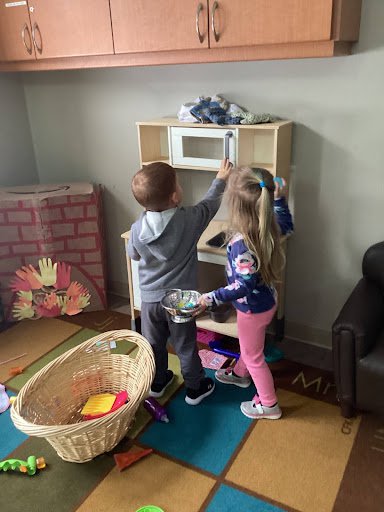
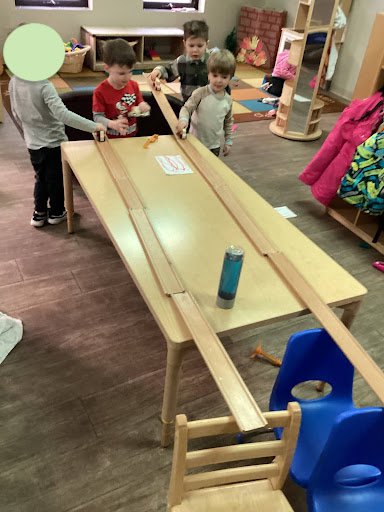
January 15, 2025
C and a peer gathered materials from the shelf and carried them to the table. They created two ramps and started racing each car down the ramps. They used the couch to elevate the start of the ramp. C and his peers gathered more ramps from the shelf to start building the road longer. As the ramps reached the end of the table, they started falling off. C said, “Our bridge won't stay up!” I said, “You might need something underneath to support your bridge.” W cheered, “Lets use a chair!” C and W grabbed chairs and placed them at the end of the table. M gathered the wooden pieces and began building the bridge. C and his peers worked cooperatively together to build and share their ideas. Once the roads were complete, they released their cars one at a time down the ramp, then drove their cars the rest of the way down the roads, making their way around the table and back to the start of the ramp.
Belonging: C participated in a shared experience with his peers; sharing ideas, building and racing their cars.
Well-Being: As C and his peers attempted to build a bridge, they quickly discovered that the wooden pieces couldn’t hang off the table without falling off. C asked their educator for assistance and they were able to come up with a solution on their own to support their bridge. C helped gather chairs and placed them at the end of the table while his peer placed the wooden pieces across.
Expression: C expressed himself creatively through the process of building the ramp, roads and bridge with his peers, by sharing ideas and building cooperatively.
Engagement: Using the couch to elevate their ramps, they raced two cars down to see which one was faster and went the farthest, experimenting with weight and speed. When their bridge continued to collapse off the table, C was able to problem solve with his peers and provide items to support underneath the bridge.
By Chelsea Kelly, RECE
December 10, 2024
A peer and T each collected a hockey stick up from the ground. Her peer backed themselves up into the hockey net while T went to the opposite side of the ice rink. She dropped the puck down by her feet. Taking her right arm, she held the hockey stick behind the puck. Her peer had then narrowed their eyes and bent her knees in preparation of the puck heading towards her. T slid her right foot while the opposite foot hung in the air. Speeding down the rink, she went back and forth, sliding her feet along the made up ice rink. Raising the hockey stick up into the air, she quickly slapped the puck forward. The puck slid across the floor and slid into the net. Immediately, her peer’s shoulders slumped forward and head bent down towards the ground. While T raised her hand in the air with her lips tugging up into a smile, she said, “I did it! I got the puck into the net!” Her peer raised her head and said, “let's do that again. I'm going to stop you next time.” The peer turned around to then bend down to retrieve the puck that was in the net. Holding the puck up, she extended her hand up with the object to give to T. The peer said, “here you go, go to the end of the rink.”
Belonging: She had been able to comfortably collaborate with her peers, by engaging in a game of hockey. They were able to set up rules, put themselves into positions on the rink and enjoyed one another’s company by jumping in right away to collect a stick off the ground.
Well-Being: She had been physically active throughout the game of hockey, using her entire body by pumping one leg up while the other was touching the rink and using her arm to extend and hit the puck with the hockey stick. She worked on her eye hand coordination skills by hitting the puck and slapping it into the net.
Expression: She had been able express her joy when shooting the puck into the net by raising her hand in the air and her lips lifting up into a smile. She was able to communicate with those around her, saying, “I did it, I got the puck into the net!”
Engagement: She was able to collaborate with her peer, by being the one who shot the puck into the net while her peer was the goalie. She expressed her joy when she scored a goal into the net.
By Jessica Martin, RECE
November 2024
The boy walked over to me with a large book in his hand. He said, “can you read this book to me, Ms. Jessica?” Nodding my head, I said, “sure we can, let's go to the carpet to read the story.” Sitting down at the bench, the boy used both hands to hand me the book, saying, “here you go, Ms.Jessica.” We opened the book called The Little Mouse, the Red Ripe Strawberry and the Big Hungry Bear. As I began to read, I would leave blanks for him to fill word gaps into the story. I would say, “Hello,” and point to the mouse in the picture. His lips would tilt into a smile before saying, “hello, mouse.” Turning to the next page, he had stuck his index finger into his mouth, as his eyes quickly focused on the pictures provided in the book. When I started filling in the next gap of the story, I said, “are you going to pick that red ripe…?” The boy looked up at me with his lips tilted into a smile before saying, “it’s a red ripe strawberry!” Laughing beside him, I said, “you are right, it is a red ripe strawberry.” As we continued through the story, he began to frown. I said, “what's wrong, [child]?” Shrugging his shoulders, he said, “where is this big hungry bear? I don't see him on the pages.” I said, “I don't know. I think because the mouse ate the entire strawberry, the bear couldn't find it.” The boy’s eyebrow pulled down before saying, “oh, the mouse just ate all the strawberry?” Nodding my head, I said, “yes, that's right [child].”
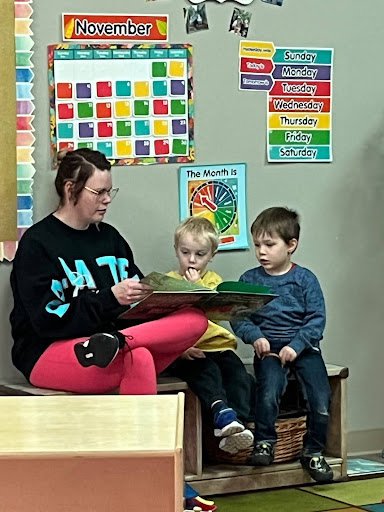
Belonging: By bringing the educator a book, the boy had wanted to read this story as a shared experience. By leaving word gaps in the story, he had been able to contribute his understanding of what word was next in the story.
Well-Being: He had been able to initiate his own learning by being able to process the protagonist being frightened of the bear eating his strawberry but the bear never appeared on the pages of the book. He used memory recall and visual discrimination to decipher what the word might be that he needed to use to fill in the gap.
Expression: Throughout the book, the boy had been able to fill in the word gaps of the story book that we had read together. He was able to express how he felt by reading the book by his lips frowning, shrugging his shoulders and his eyebrows pulling down.
Engagement: He had used his eyes to focus his attention on the details of the book which assisted him in being able to fill in the word gaps of the story that we had read together. By leaving word gaps open for him to fill in the blank spot, this supported a better understanding of early literacy.
By Jessica Martin, RECE
October 2024
At the the educator placed a pumpkin, a mallet, a few cookie cutters and a knife. As the educator held the pumpkin up for the children to see, she began to push the knife into the top of the pumpkin. As the knife went in and out of the top of the pumpkin, the child’s eyes widened with her mouth opening into an “o” form. Trying to get closer, she used both of her hands to pull the two garbage bags that were laid out on the table under the pumpkin. As the garbage bag moved, so did the pumpkin that the educator was cutting. The educator held the pumpkin steady and stopped cutting. She said, “Please do not pull the garbage bag, if we pull it, that moves the pumpkin to which I could miss and cut my finger.” Making eye contact with the children, the educator then said, “put your hands down behind your back to keep me safe, please and thank you.” Right away, the child lifted both her hands and placed them behind her back, saying, “I'm ready.” The child continued to demonstrate how to be safe by keeping her hands behind her back until the educator was done cutting the top of the pumpkin out.
Belonging: By placing her hands behind her back, the child showed concern for the educator’s well-being when she was cutting out the top of the pumpkin.
Well-Being: By making the decision to keep the educator safe, she placed both of her hands behind her back and used her communication skills to tell the educator that she was ready.
Expression: By listening to the educator, the child learned about consequences because if she were to keep pulling on the garbage bags that she could have pulled the pumpkin to which could have resulted in the educator getting cut.
Engagement: By focusing her attention on the educator, the child was able to follow through on what the educator had asked by placing her hands behind her back and saying “I'm ready.”
Written By Jessica Martin, RECE
September, 2024
The children gathered around the carpet, as I said, “come to the carpet, we are going to do an exciting activity.” A few of the children shouted, “what are we going to do?” I said, “we are going to look for animal footprints around the daycare. We have to look up high and look down low.” As the children began to look up at the walls, they began to spot the tracks. A boy ran up to one and used his right index finger to point to the tracks. He said “I found some tracks. Look, it's an animal.” Nodding, I said, “you found squirrel footprints, you can go take down the tracks from the wall.” Reaching up onto his tip toes, he used his thumb and forefinger to pull the squirrel tracks off the wall. Using both hands, he held the picture close to his face to see the outlines of the footprints, before turning the laminated paper over to see green tape. Using his thumb and forefinger, he pried the tape away from the paper and held it up to me. He said, “garbage? Can you take it?” Nodding my head, I placed the tape into my hand.
Belonging: The entire class had been invited to come join the activity, they were able to search and pull the laminated animal tracks off the wall. The boy was able to participate alongside his peers.
Well-Being: By looking up and down throughout the daycare, he had been able to tackle this new learning activity by being hyper-focused on searching for the hidden animal tracks.
Expression: By using his words, the boy had been able to formulate his responses on how he found some animal tracks and was able to listen to his educator on what animal tracks he had found in the daycare centre.
Engagement: By looking up and down around the walls of the daycare centre, he had been able to focus his attention on spotting the animal tracks. He was able to communicate his findings to the educator when he spotted the tracks.
By Jessica Martin, RECE
August 27, 2024
The child watched me as I folded and tore some paper into smaller pieces to add to our art shelf. After a few minutes she asked me very quietly, “can you make me a paper airplane?” She waited patiently as I folded the paper making a paper airplane. Once it was complete, I handed it to her. Off she went, gliding it through the air in every direction throughout the classroom. She told her friends that, “Miss Mandy made me a paper airplane.” After a few minutes, another child came to me and asked me to make them a paper airplane. Slowly, children came up one after the other asking me to make them a paper airplane. I saw the girl stand in one spot, watching all of her friends flying their paper airplanes. One of her friends did not have one yet. She then came to me and asked if I could make her friend an airplane. Once all of the children had their own paper airplane, I asked the girl, “how did you know about making a paper airplane?” She said to me, “Mommy and Daddy made me a paper airplane.” She then walked away and started throwing her plane with her friends. I watched as the girl climbed up on a new piece of stable furniture in our room to toss her plane from up higher. She then crouched down and tried to fly it through the center opening of the furniture, watching it come out the other side. She continued taking turns with her friends and moving around the room to find different places to throw their planes. They communicated with each other, talking about the different things they can do with their planes, saying things like, “Watch my plane go through the hole,” and “Watch it go up in the tree”, and “Watch it fly down”.
Belonging: The child is able to communicate with her educator and peers with ease. She is able to show me full participation. She shows a connection between home and daycare when we talk about how she knew about paper airplanes, telling me that her Mommy and Daddy have made them for her too.
Well-Being: She used her fine motor skills to grip her paper airplane with her thumb and pointer finger, flying the plane across the room. She uses her motor skills to navigate the room, finding other ways to watch her plane fly through the air. She experimented with climbing furniture to throw it up high and crouching down to throw it through spaces down low.
Engagement: The child tests out her plane in different ways around the room. She is able to stay engaged and focused in her play. She shows joy and excitement on her face as she plays alongside her peers, trying out different ways they can throw their planes together. They talk amongst themselves and show each other what they can do with their planes.
Expression: The child is able to express herself and interact with her peers and educators with meaning. She moves around the room, talking back and forth with her peers and her educators as she plays with her paper airplane.
Written By Mandy Bertling Beres, RECE
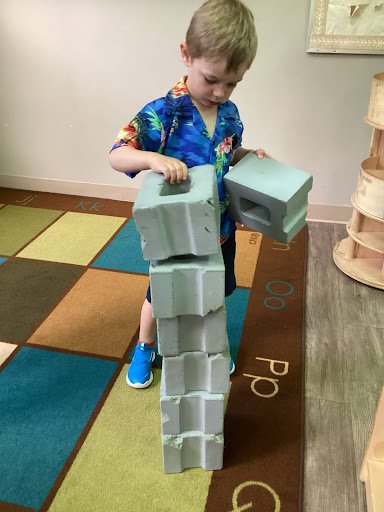
July 5, 2024
A child approached the building block shelf after arriving in the morning and picked up one block at a time, stacking them one on top of the other. I approached him and asked, “What are you building [child]?”. He looked up at me, smiling, and said, “I’m making a tower!” I stepped back for a few minutes as I observed him building his tower. I then approached him and asked, “How many blocks tall is your tower?” Pointing to one block at a time, he counted, “One, two, three, four, five, six, seven, eight!” He was so excited as he counted and then knocked it down with his hands. He started laughing and said, “Now I have to make a new tower.” He continued again and a peer decided to join him. His peer ran over to the play kitchen and said, “You want to put some food in the tower?” The child said, “Yes! It can be a food tower.” They built the tower up high and the boy and his peer added the play food into the center of it. I then went to the boys and said, “Did you know that there are food towers in real life, and they’re called silos?” The boys looked at each other, smiled and kicked and pushed down their tower. They then picked everything up and started all over again.
Belonging: The child is comfortable in the classroom and uses his imagination while making creations with building blocks. He is showing confidence in building with his peers and communicating positively while building and accepting new ideas from his peers.
Well-Being: He showed that not only did he value the input of his peer but was also able to show that he was capable and competent to build a tower and count the blocks. The boy was able to self-regulate his emotions as they broke the tower and problem-solved as they rebuilt the tower.
Engagement: The boy and his peer interacted positively with the blocks, while making decisions together, adding blocks and pretend-play food to their tower. They accepted each other’s input on what they were making and were curious about what the outcome would be after breaking the tower and closely observing to see where the food would go.
Expression: The child is showing his ability to build relationships by engaging in a positive way and by collaborating with his peer in their food tower creation. He was inclusive by allowing his peer to join and accepting to add a different material to his tower that he wasn’t originally using. They problem-solved as they broke and re-built their tower.


